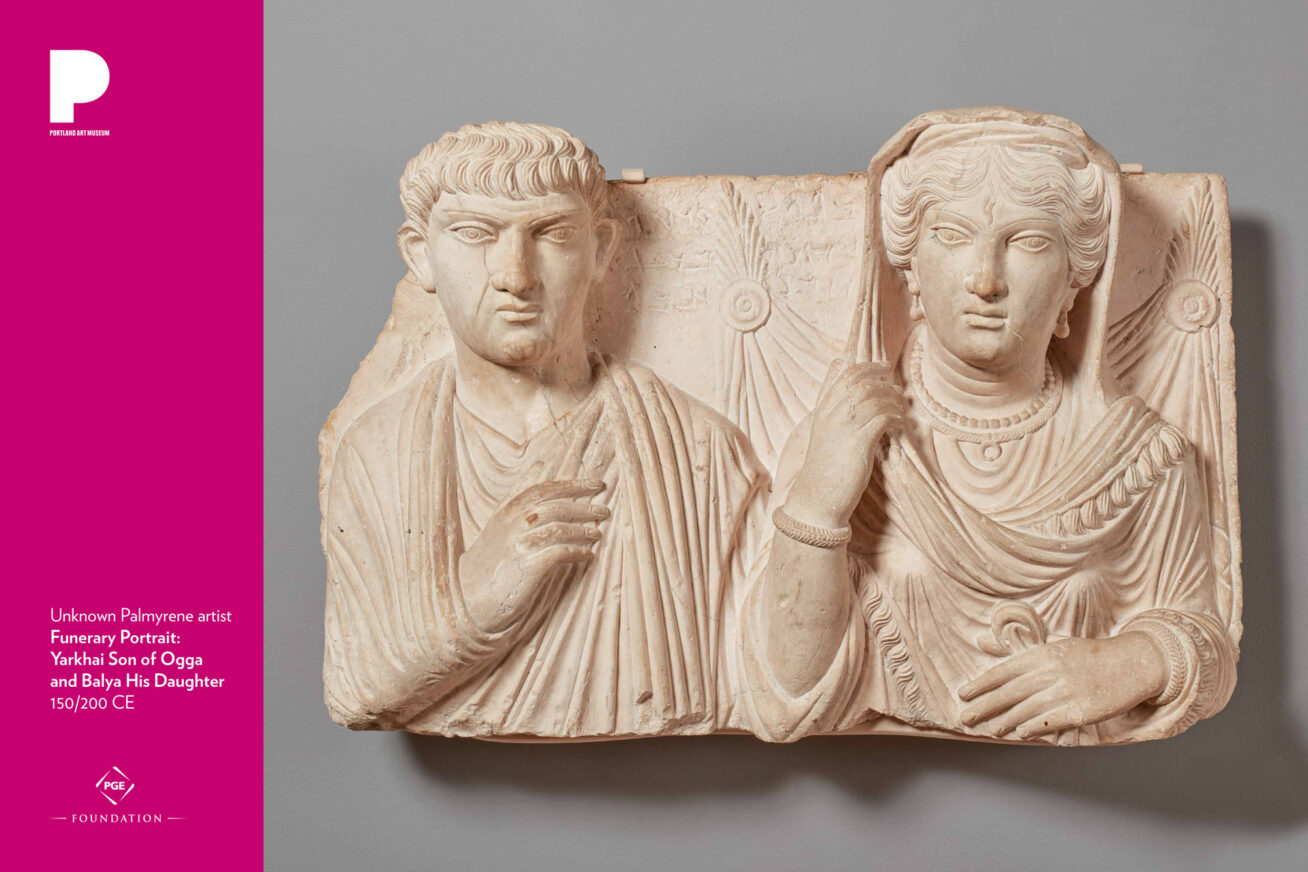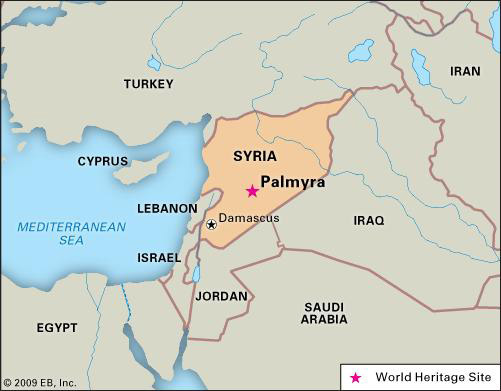
This portrait of a father and daughter was carved in the great ancient city of Palmyra (also called Tadmur) almost two thousand years ago. Then part of the Roman Empire, Palmyra grew internationally sophisticated and wealthy as a major outpost for trade caravans in the Syrian Desert. The local population embraced Roman ways in many aspects of their lives, as evidenced in the hairstyles and clothes depicted here, as well as by spectacular architecture and sculpture.
The form of this work—with side-by-side figures posed frontally—was inspired by traditional Roman tomb monuments. Couples usually depict a husband and wife, but the inscription in the Palmyrene dialect of Aramaic identifies the people as Yarkhai, son of Ogga, and his daughter Balya. The father’s right arm is held in a sling created by the draping of his cloak. The daughter raises her right hand to touch her veil and, with her left hand, holds the end of her cloak. These gestures follow the conventions of hundreds of surviving Palmyrene funerary sculptures and offer clues as to how wealthy men and women of Palmyra wanted to be seen and remembered by their families and their peers. Scholars believe that these poses may have indicated virtues, such as dignity and modesty. The sculpture was made for a wall tomb in a tower or temple setting and would have been accessible to later generations. We know Balya died before her father did from the drape suspended behind her on pins with palm fronds. The figures have a strong sense of presence appropriate to their function of commemorating the departed.
This sculpture carries special significance in light of the recent destruction of many ancient works of art and architecture in Syria. From the first to the third century, the art and architecture of Palmyra, standing at the crossroads of several civilizations, united Greco-Roman, Persian, and Indigenous elements in a strongly original style. The ruins of the ancient city were designated a UNESCO World Heritage Site in 1980 in recognition of its history as one of the most important cultural centers of the ancient world. However, the country of Syria has been engulfed in civil war since 2011, when a civil uprising escalated into a brutal, multiparty conflict between the government of Bashar al-Assad and various armed factions. One of these factions is the Islamic State, also known as ISIS. ISIS militants have methodically destroyed numerous artworks and ancient sites across Syria and Iraq, claiming that the works are blasphemous, while also profiting from the illegal trade in looted antiquities. In the spring of 2015, Khaled Asaad, the elderly former curator at Palmyra, his colleagues, and his family worked heroically to conceal or evacuate artifacts as Islamic State forces approached. ISIS overran Palmyra in May 2015, publicly executed Khaled Asaad, and blasted the ancient ruins with explosives. Syrian government forces recaptured Palmyra in March 2017 and archeologists have begun to assess the damage to the historic sites. Human rights organizations report that, as of March 2017, over 465,000 people have been killed in Syria’s civil war. Eleven million people have been forced to flee their homes and seek safety in other parts of Syria and, as refugees, in other countries.
The Funerary Portrait: Yarkhai son of Ogga and Balya his Daughter came to the Portland Art Museum through the generosity of a prominent, Syrian American, Oregon family. In 1954, Aziz E. Atiyeh donated three Palmyrene funerary sculptures to the museum. Atiyeh had immigrated to the United States from Amar El-Husn, Syria (then part of the Ottoman Empire), in 1897 at the age of 17. After several years in Pennsylvania, he moved to Oregon, where he was joined by his brother George Aziz. They established the Atiyeh Bros. store, importing and selling Oriental rugs, in downtown Portland, a successful business that continues to be family-owned. George’s youngest son, Victor George Atiyeh, became the first Arab American governor in the United States when he served as governor of Oregon from 1979 to 1987.
Discussion and activities
- Look closely at the portrait of Yarkhai and Balya. Write down 10 details about the work. What do you notice about their postures, clothes, jewelry and hairstyles, their facial expressions? As discussed in the essay above, the figures in this portrait show conventional poses and clothing styles—many Palmyrene funerary portraits portray men and women in similar positions. At the same time, the sculptures provided an important form of self-representation. What do you think Yarkhai and Balya wanted to convey about themselves?
- Compare this Funerary Portrait from ancient Palmyra to the 1898 studio photograph Portrait of a Couple. Make a list of the differences between these works. Then, make a list of the similarities. What do these works have in common?
- Imagine that you are having your portrait made with an eye both to the present and to future generations. How would you like to be remembered? What material would you choose for the portrait? Would it be two- or three-dimensional? Formal or casual? Individual or with another person or people?
- You may often photograph or draw people, but have less experience creating three-dimensional portraits. Create a portrait sculpture of yourself or someone you know using any available material. (Clay, pipe cleaners, wikki stix, and aluminum foil are all good options.) How does the three-dimensional medium effect your process? What are the different choices you have to consider?
- We perceive ancient Palmyrene sculptures as white, due to the characteristics of limestone. But when researchers examine these works with the aid of powerful microscopes, they find some evidence that the sculptures may originally have been brightly colored. What colors would you add to this work? Print the image of the Funerary Portrait from the PDF available online and make it colorful with pencils, markers, paint, or other materials. How do the colors change your perception of the sculpture?
Recommended resources

- The Getty Research Institute, The Legacy of Ancient Palmyra, online exhibition
- Rubina Raja, Palmyra Portrait Project
- Maura K. Heyn, “Gesture and Identity in the Funerary Art of Palmyra,” American Journal OF Archaeolog, 114, no. 4 (October 2010), pp. 631–661.
- Ancient Feast of Color: Digital Microscope Sheds Light on Classical Sculptures
- Patrick J. McDonnell, “ISIS militants battered Syria’s ancient Palmyra, but signs of splendor still stand,” Los Angeles Times (June 2, 2017).
- Oregon Encyclopedia, Victor Atiyeh (1923-2014)
- Atiyeh family history
Spanish-language PDFs developed with the support and collaboration of
